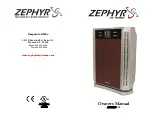
-
21
-
'16 • SCM-T-199
Power source voltage complies with the rated voltage of air-conditioner.
Earth leakage breaker and circuit breaker are installed.
Power cable and connecting cable are securely fixed to the terminal block.
Both liquid and gas service valves are fully open.
No gas leaks from the joints of the service valves.
Indoor and outdoor side pipe joints have been insulated.
Drain hose (if installed) is fixed properly.
Screw of the service cover is tightened properly.
Connecting
cable
Power
source
cable
Cable clamp
Connecting
cable
Power
source
cable
Cable clamp
5. ELECTRICAL WIRING WORK
2.Connecting cable
(1) Remove the service cover and the terminal cover.
(2) Connect the cables according to the instructions and figures given below.
(a) Connect the earth wire of power source cable.
An earth wire must be connected before connecting the other wires of power source cable.
Keep the earth wire longer than the remaining two wires of power source cable.
(b) Connect the remaining two wires (N and L) of power source cable.
(c) Connect the wires of connecting cables. Make sure that for each wire, outdoor and indoor side ter-
minal numbers match. Terminal number A of the outdoor unit is used for A indoor unit and terminal
number B for B indoor unit respectively.
Earth wire shall be Yellow/Green (Y/G) in color and longer than other wires for safety reason.
(3) Fasten the cables properly with cable clamps so that no external force may work on terminal connec-
tions.
Moreover, make sure that cables do not touch the piping, etc. When cables are connected, make sure
that all electrical components within the electrical component box are free of loose connector coupling
or terminal connection.
<Circuit diagram>
N L
Circuit
breaker
Earth
leakage
breaker
Earth
Power
source
Outdoor unit
Power
source
cable
Indoor unit
1 2 3
1 2 3
1 2 3
unit A
unit B
unit C
unit A
unit B
1
2
3
1
2
3
1
2
3
unit C
Connecting cable
<SCM40/45>
View of terminal block
unit A
unit B
Power
source
<SCM 50/60>
View of terminal block
Power
source
unit A
unit B
unit C
6. FINISHING WORK
NOTE
● Make sure to match the piping and wiring from each unit to the outdoor unit.
● Be careful because if connections are wrong, normal operation cannot be achieved and may damage the
compressor.
Piping
Wiring
Indoor unit
Indoor unit
unit C
unit B
unit A
Outdoor
unit
C
A
B
unit C
unit B
unit A
Outdoor
unit
C
A
B
1. Heating and condensation prevention
(1) Dress the connecting pipes (both liquid and gas pipes) with insulation to prevent it from heating
and dew condensation.
Use the heat insulating material which can withstand 120°C or higher temperature. Make sure that
insulation is wrapped tightly around the pipes and no gap is left between them.
(2) Wrap the refrigerant pipings of indoor unit with indoor unit heat insulation using tape.
(3) Cover the flare-connected joints (indoor side) with the indoor unit heat insulation and wrap it with
an insulation pad (standard accessory provided with indoor unit).
(4) Wrap the connecting pipes, connecting cable and drain hose with the tape.
(2)
(3)
(4)
Tape
Insulation pad
Position it so that the slit area faces upward.
Connecting cable
Liquid pipe
Drain hose
Gas pipe
Insulation
Tape
NOTE
Locations where relative humidity exceeds 70%, both liquid and gas pipes need to be dressed with 20mm
or thicker heat insulation materials.
CAUTION
• Improper insulation can cause condensate(water) formation during cooling operation.
Condensate can leak or drip causing damage to household property.
• Poor heat insulating capacity can cause pipe outer surface to reach high temperature during heating
operation. It can cause cable deterioration and personal injury.
2.Finishing work
(1) Make sure that the exterior portion of connecting pipes, connecting cable and drain hose is wrapped
properly with tape. Shape the connecting pipes to match with the contours of the pipe assembly route.
(2) Fix the pipe assembly with the wall using clamps and screws. Pipe assembly should be anchored ev-
ery 1.5m or less to isolate the vibration.
(3) Install the terminal cover and the service cover securely. Water may enter the unit if service cover is
not installed properly, resulting in unit malfunction and failure.
Pipe assembly
Screw
Clamp
CAUTION
Make sure that the connecting pipes do not touch the components within the unit. If pipes touch the
internal components, it may generate abnormal sounds and/or vibrations.
7. PUMP DOWN
(1) Connect charge hose of gauge manifold to a service port of outdoor unit.
(2) Close the liquid service valves for all connected indoor units with hexagonal wrench key.
(3) Fully open the gas service valves with hexagonal wrench key.
(4) Carry out forced cooling operation for all connected indoor units (For forced cooling operation procedure,
refer to indoor unit installation manual).
(5) When the low pressure gauge becomes 0.01MPa, close the gas service valves and stop forced cooling
operation.
Gauge manifold
Charge hose
Service port
8. INSTALLATION TEST CHECK POINTS
After finishing the installation work, check the following points again before turning on the power.
Conduct test run (Refer to indoor unit installation manual) and ensure that the unit operates properly.
















































